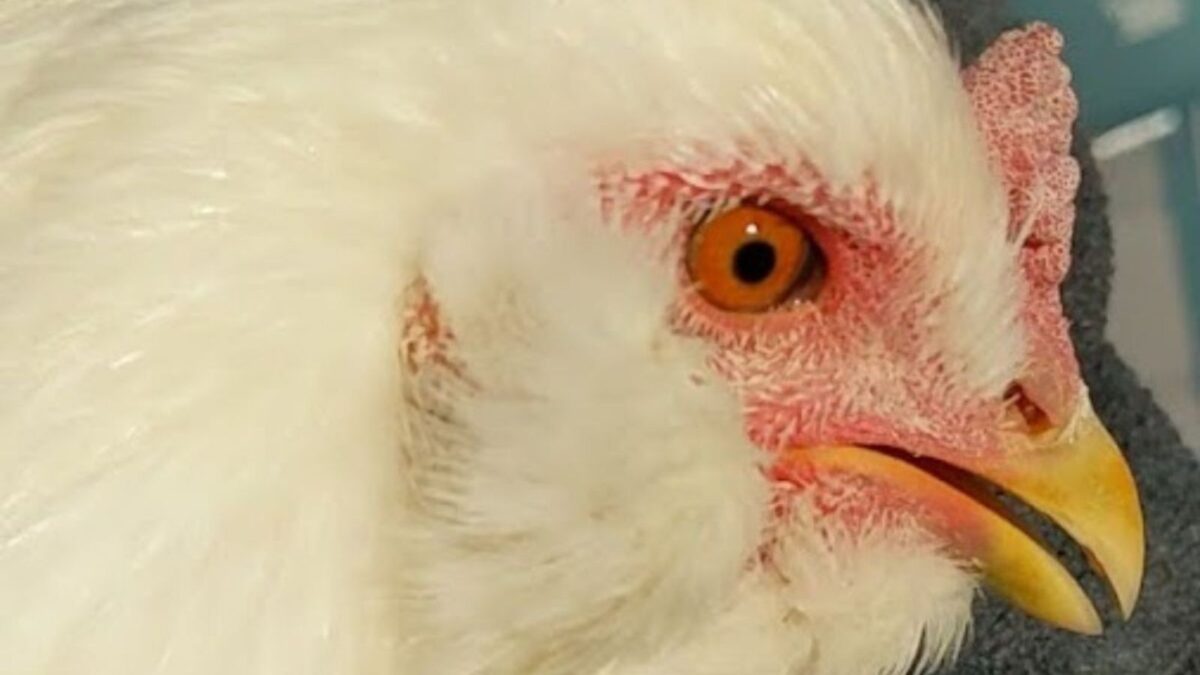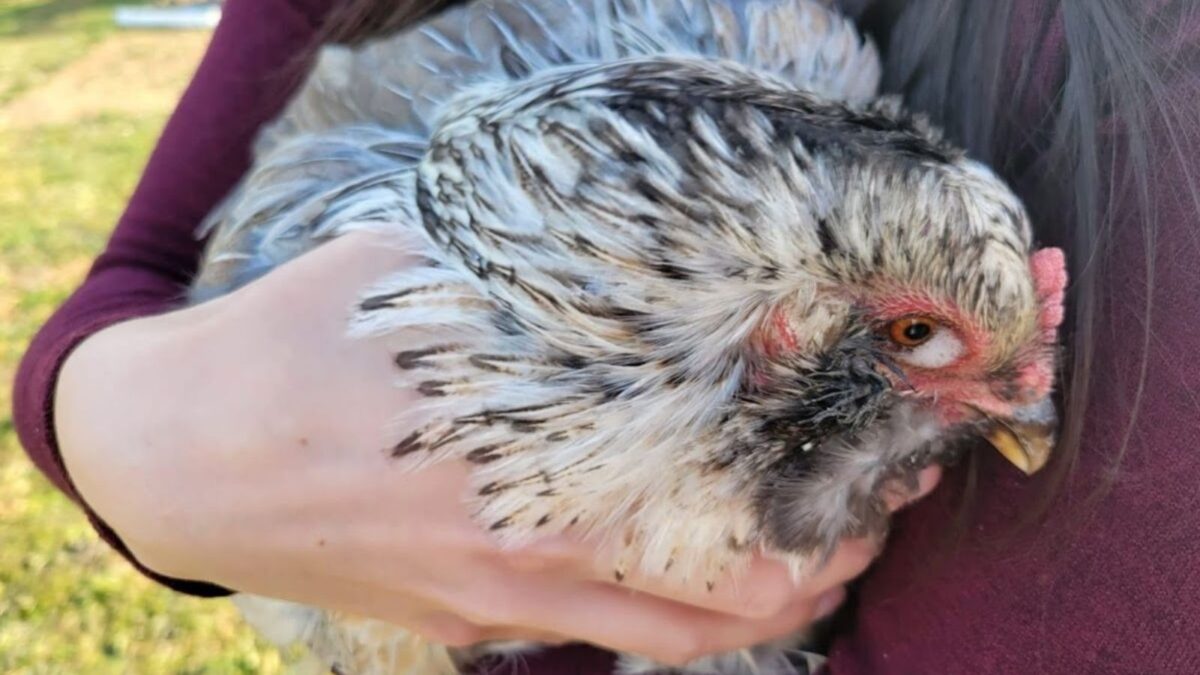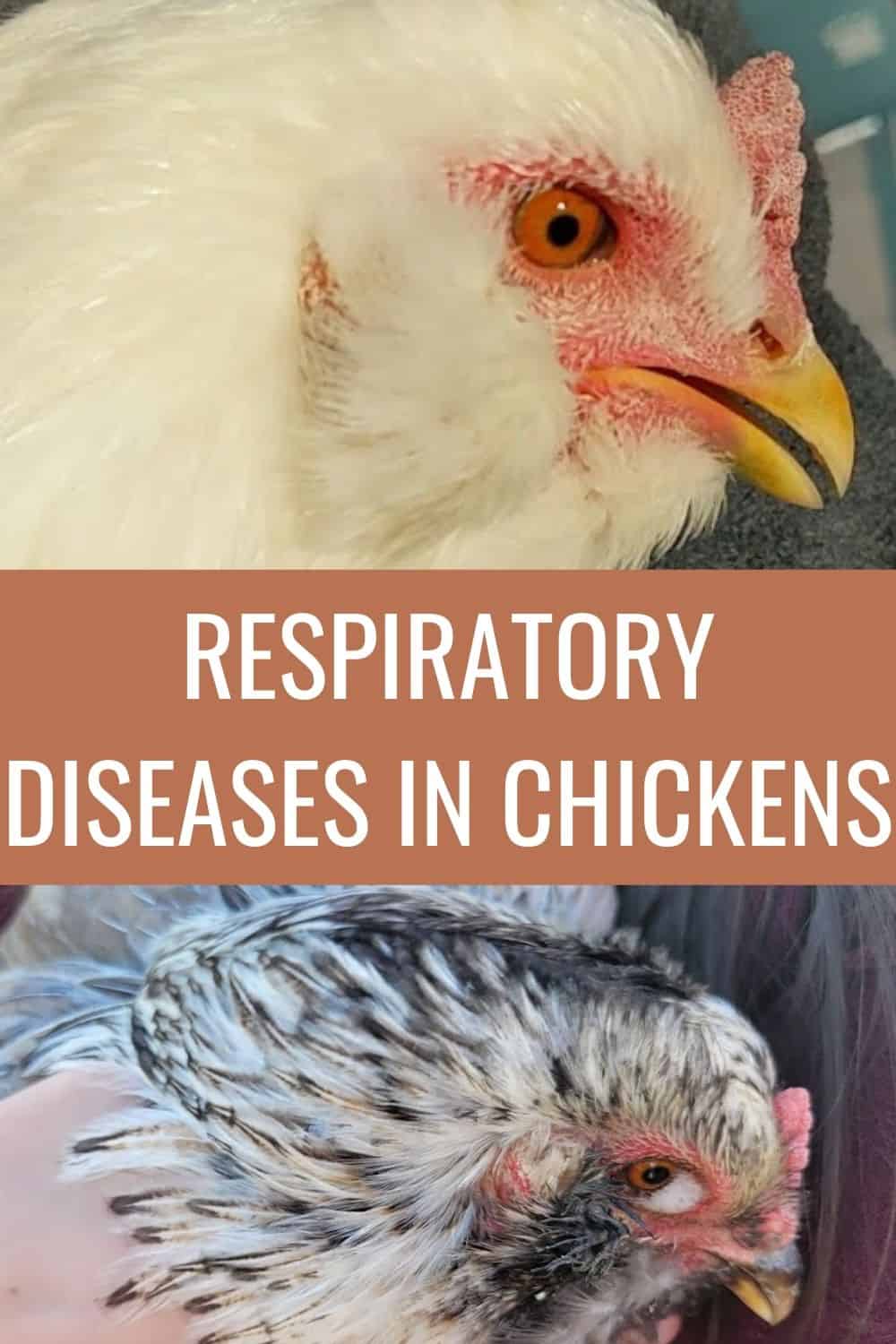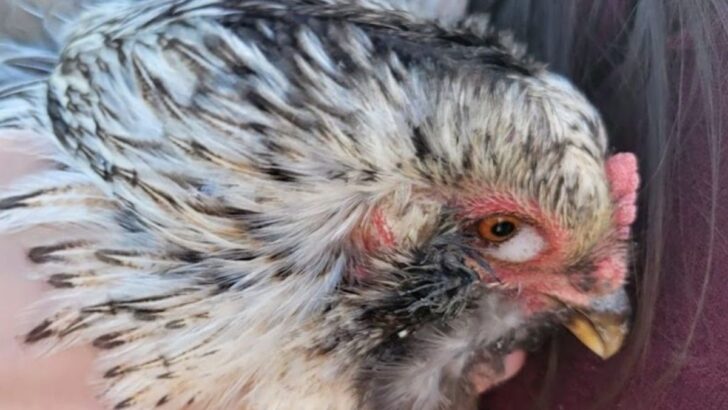As a chicken owner, you will inevitably experience a respiratory disease within your flock at some point. Chickens are notorious for respiratory ailments. Today, we’ll look at respiratory diseases in chickens, what causes them, how you can take steps to avoid them, and how to treat them.

Respiratory Diseases In Chickens
There are several types of respiratory diseases that plague chickens. This article will discuss some of the more common diseases backyard chicken owners may encounter. Here is a breakdown of the diseases that will be covered:
- Infectious coryza
- Fowl cholera
- Chronic respiratory disease
- Infectious Bronchitis
- Gapeworm
- Newcastle disease
- Avian influenza
1. Infectious coryza
Infectious coryza is caused by a bacterial infection (haemophilus paragallinarum) that affects the respiratory system in chickens. It is highly contagious and can affect all ages of chickens, although chicks under four months are typically unaffected.
It seems to be isolated only to chickens and does not affect other species of birds. It is also not a zoonotic disease, so it cannot be transmitted to humans. The disease can be carried by chickens that otherwise appear to be healthy and are harboring the disease or by chronically sick birds.
Infectious coryza is transmitted through birds in direct contact with one another, by airborne droplets, and through drinking contaminated water.
The most common signs of infectious coryza are:
- discharge from the nostrils
- watery eyes
- swelling of one or both sides of the face.
The most distinct symptom is a foul-smelling odor from the chicken’s head. Once you smell it, you will never forget it. Other symptoms may include lethargy and loss of appetite.
If you notice your bird presenting with any of these symptoms, you will want to immediately separate them from the flock. You’ll need to treat with antibiotics via drinking water.
Erythromycin and oxytetracycline can be very effective if the disease is caught early. If the disease is too far advanced, the treatment may only prove to be effective during the administering period. Once the treatment stops, the disease may resurface.
A chicken that has been infected with infectious coryza and survives will always be a carrier. This means that any existing birds in your flock and any new birds you bring in will be exposed.
There is a vaccination for infectious coryza, but it should only be used to prevent future outbreaks once coryza has been diagnosed in the flock. After the flock has been vaccinated, they must be revaccinated twice a year. Although the bacteria don’t live long when it is outside of the chicken’s body, once they have become established in your flock, the only way to truly rid your premises of the disease is to dispose of all the chickens, disinfect the entire area and leave coops and runs vacant for three weeks before reestablishing a future flock.
Infectious coryza is not transmitted through the egg, so hatching eggs from infected birds is fine if you are not introducing the chicks into an infected environment. If you did decide to cull an existing flock, you could preserve the lines by hatching eggs from them. This could help to make the loss a bit more palatable.
2. Fowl cholera
Fowl cholera is caused by various strains of a bacteria called Pasteurella multocida. The different strains result in two forms of cholera: acute and chronic. These two different forms are quite distinct, but the signs can overlap when a survivor of the acute form becomes chronic.
All domestic poultry and wild birds are susceptible to this disease. Turkeys and ducks are more susceptible than chickens, and mature chickens are more susceptible than young birds. Any chicken that recovers will remain a carrier.
Acute cholera
The acute form of fowl cholera is highly virulent and deadly. It is caused by fast-acting blood poisoning from bacterial toxins. The chicken dies without showing any signs of illness. They can look perfectly fine one minute and be dead a moment later.
The less dramatic form may cause symptoms such as lethargy, no appetite, diarrhea, labored breathing, and mucous from the mouth. Birds may survive the acute form of fowl cholera only to die of emaciation and dehydration or become chronic eventually.
Chronic cholera
In contrast to the acute form of fowl cholera, chronic cholera develops slowly and invades specific body parts. It is sometimes called mild fowl cholera because it is not nearly as dire as the acute form.
Symptoms of chronic fowl cholera include lethargy, fever, loss of appetite, swollen wattles, sinuses, joints, ears, and footpads, increased respiratory rate, and mucous coming from the mouth.
Treatment for chronic cholera consists of a course of antibiotics. Oxytetracycline in the water and feed is the most effective. Must be given in both to be effective. A course of probiotics can also be beneficial to help improve gut health. Remember that the disease will most likely reoccur when treatment is stopped.
The best way to avoid fowl cholera is to practice good management in your flock. Do not bring in older birds that could be carriers, and don’t mix birds of different ages from different places. There is also a live vaccine available that can help boost immunity, but it should only be administered in healthy flocks.
3. Chronic respiratory disease

Chronic respiratory disease (CRD) is caused by Mycoplasma gallisepticum. It is a contagious disease that develops slowly and becomes chronic; it sometimes appears to go away but will return.
CRD usually affects full-grown birds, causing them to produce fewer eggs, but it doesn’t typically cause death. Those birds that recover from an infection do not tend to become reinfected but remain carriers and can spread the disease to other birds in your flock.
Symptoms of CRD include weepy eyes in the mild form and swelling and foaming of the eyes in more severe cases. Other symptoms include discharge from the nose, sneezing, coughing, and, in serious cases, airsacculitis (infection of the air sacs).
CRD is spread through direct contact with an infected chicken or a carrier bird. The chances of them contracting the disease increase in cold temperatures and coops with poor ventilation. It can be passed from hens to chicks through the egg.
In a lot of cases, CRD will occur following a bronchitis infection. Also, stressful events can bring out a CRD infection, such as moving from one place to another, a predator attack, overzealous mating, etc. Any activity that causes the bird to be overly stressed.
Treatment for a very mild case of CRD involves applying a cream to the eye. This generally will alleviate the symptoms in about two days. For more severe cases, a course of antibiotics should be given, as well as eye cream.
Combining doxycycline and tylosin in the drinking water for seven days is recommended. You’ll want to treat the remainder of your flock with a five-day antibiotic treatment.
If the infection is too severe, the bird may be beyond treatment and should be culled to prevent further infection of your flock. You will also want to clean and disinfect the coop, the run, and all equipment, including feeders and waterers.
A vaccine is available for CRD, although it does not prevent infection.
4. Infectious bronchitis virus
The infectious bronchitis virus (IBV) in chickens is a highly contagious disease affecting the upper respiratory and female reproductive tract. It also causes a decrease in egg production and quality. Infection in conjunction with CRD can exacerbate the disease. IBV affects chickens of all ages, but young chicks appear to be the most severely infected.
Symptoms include coughing, sneezing, rattling, and sometimes facial swelling in chicks. In adult birds, appetite decreases and a drop in egg production are the biggest indicators. Eggs may be misshaped, have ridges, are thin, soft, or of poor internal quality. This is caused by lesions in the reproductive tract associated with the disease.
IBV is spread by airborne droplets from bird to bird. It also can be spread through feces and contaminated materials and equipment. Birds that recover from the disease will always be carriers and can infect other chickens in your flock.
Antibiotics are the best course of treatment against IBV. Keeping birds warm may also help in the recovery process. Preventative measures can be taken, such as not bringing outside birds onto the property and properly cleaning and disinfecting all areas.
5. Gapeworm
Gapeworm (Syngamus trachea) is a roundworm that affects the chicken’s trachea by burying its head into the lining and causing the bird to yawn or gasp frequently. The disease is called gape or “the gapes” because the chicken constantly raises its mouth to take in air.
A gapeworm is large enough to be seen without magnification, is red in appearance, and has a paler-colored male worm permanently attached to it, forming a Y shape.
A chicken infected with gapeworm will cough up the worm eggs, swallow them, and then excrete them in their droppings. When another chicken eats the eggs that were excreted, they, too, become infected. This is the direct cycle of infection. An indirect infection cycle would be if another entity ate the eggs, say a fly or earthworm, and the chicken consumes that insect.
The most obvious symptom of a chicken infected with a gapeworm is gasping for air by stretching their necks and opening their beaks. A hissing sound sometimes accompanies this.
Other symptoms include weight loss, lethargy, and constant shaking of the head to try and dislodge the obstruction in the throat. Typically, younger birds are more severely infected and will deteriorate quickly. Older birds tend to tolerate the infection better and sometimes will show almost no signs.
Treatment for birds with gapeworm consists of a round of flubendazole or by applying ivermectin poured topically on your bird. Keeping their coop and run clean is a great way to prevent gapeworms from infesting your chicken’s living spaces.
6. Newcastle disease (ND)
Several forms of Newcastle disease affect chickens, but the lentogenic strain is the most common form in the United States. Luckily, this is the least deadly of the strains and rarely causes death. The other strains are much more severe but are typically only seen overseas. The lentogenic strain of Newcastle presents in two forms: intestinal infection and respiratory infection.
The respiratory infection form of lentogenic ND causes coughing, gasping, and abnormal breathing sounds in chickens. It has been known to sometimes cause nerve disorders, such as paralysis of a wing or leg, in addition to respiratory symptoms.
Since a virus causes Newcastle disease, there is no specific treatment. Your veterinarian may prescribe an antibiotic for any secondary bacterial infection that may arise, but the virus just has to take its course. The good news is it is rare for a bird to die of the lentogenic strain of Newcastle disease.
7. Avian influenza
Avian Influenza, also called the bird flu, is carried by wild birds. Specifically seabirds, shorebirds, and waterfowl. Several orthomyxoviruses cause it, the same type of viruses that affect mammals. The type that affects birds is called type A.
While wild birds will not typically show signs of the disease, they can spread the virus amongst themselves and other species. Chickens are not usually a natural host for the flu virus, but they have become more susceptible through domestication.
These type A viruses have existed for hundreds of years and evolved into many strains. These many strains have been grouped into two main categories: low pathogenic and high pathogenic.
Low Pathogenic Flu
Most avian forms of the flu are low pathogenic. These strains are prevalent worldwide and, in most cases, have little to no effect on backyard chickens.
Symptoms can include coughing and sneezing, loss of appetite, diarrhea, declining egg production and fertility, and nervous system issues. If chickens are housed in overcrowded and unsanitary conditions, the low pathogen can mutate and become a high pathogenic flu.
High Pathogenic Flu
The highly pathogenic form of bird flu can spread fast and be deadly. This form is most commonly seen in commercially raised flocks, quarantined and destroyed to stop the spread.
Avian influenza spreads much the same as the flu in humans. It is transmitted through respiratory droplets from the nose, eyes, and mouth through sneezing and coughing. It can also be spread through infected feces as well as equipment and materials that have become contaminated. Chickens that survive will become carriers.
Symptoms of high pathogenic flu include sudden death, loss of appetite and dehydration, twisted neck, and death within two days.
The best way to avoid an avian influenza outbreak is to practice good biosecurity measures and suspend free-ranging your chickens if cases have been reported in your area.
Bio Security For the Health of Your Flock
The bottom line is disease is everywhere, and sometimes, no matter what you do, it will eventually affect your flock. An infected wild bird could fly over your pen and deposit droppings your chickens come into contact with.
Your chicken could eat an earthworm carrying gapeworm larvae. There are so many different scenarios I could spend all day writing them. The best thing you can do as a steward of your flock is to practice good bio-security measures. This includes:
- Not allowing outsiders to come in direct contact with your birds.
- Have visitors wash their hands and enter a disinfecting solution when they visit your property. A shallow pan of bleach water generally does the trick.
- Do not bring new birds onto your property; in other words, have a closed flock.
- If you bring new birds onto your property, you must quarantine them for at least 30 days away from your existing flock. You must wash your hands and change your shoes before moving between spaces.
- Keep your coops and runs clean. Daily spot cleaning of coops and a sweep out of runs once a week, especially in small, confined situations, is key.
- If one or more of your birds shows signs of being sick, remove them from the flock immediately and isolate them.
- Thoroughly clean and disinfect any areas where sick birds have been. This includes any feeders and waterers they’ve used.
- If a bird dies due to illness you may want to take them to a state lab to have them necropsied. This way you can get a more accurate diagnosis of what the bird died from.
And in summation, be smart. Practice good management of your flock and their habitat and you should have healthy, happy birds for a long time.
Other diseases your chickens might suffer from
- What Is Bumblefoot In Chickens And How To Treat It
- How To Treat Coccidiosis in Chickens
- What Is Marek’s Disease In Chickens
- Get my book about raising chickens to get all the details in one spot
FAQs about chickens’ respiratory infections
How do I know if my chicken has a respiratory infection?
A respiratory infection will affect the lungs, nostrils, sinus cavities, eyes, and throat of a bird. Signs include coughing, sneezing, wheezing, trouble breathing, runny nose, runny eyes, mucous, loss of appetite, diarrhea, decreased egg production, reproductive problems, and sometimes neurological issues. If you notice one or more of these signs you’ll want to observe the bird to determine what illness they may be struggling with and how to treat it.
What causes respiratory diseases in chickens?
There are several different catalysts for respiratory disease in birds. They can be a virus, bacteria, and even a worm. It is in the best interest of the bird to find out which of these is causing the respiratory distress in your bird so that you can properly treat it.
Bacterial infections are typically treated with an antibiotic while a worm infestation would be corrected with a dewormer. Viral infections cannot be treated with medicine but there may be things you can do to keep the bird more comfortable and aid in the speed of recovery.
Can humans get a respiratory infection from chickens?
While it is possible, it is not very common. Zoonotic diseases are those that can travel between species, but when it comes to chickens your chances of contracting a respiratory infection from them are extremely low. You are more likely to contract things like pinkeye or ringworm from your birds than you are the bird flu.



Quick Guide To Raising Backyard Chickens
Thursday 28th of July 2022
[…] 7 Respiratory Diseases In Chickens And What To Do When Your Chickens Get Them […]
6 Common Types Of Worms In Chickens: How To Prevent, Detect, And Treat
Thursday 3rd of March 2022
[…] Related: Respiratory diseases in chickens […]